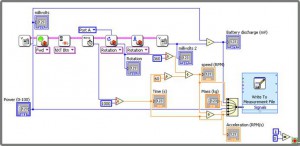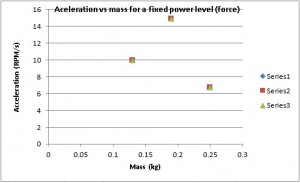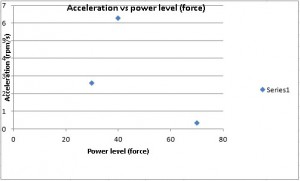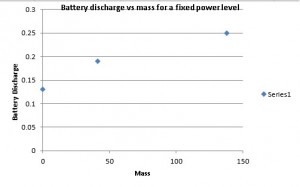 During the course of the last week the “Contemporary Science and Innovation” class has been experimenting with Lego robots to understand: Force and Energy, Velocity and Acceleration, and Power. As mentioned in my previous blog about Lab #1 the class is completing the labs using Lego Mindstorm NXT. Which is a robotics kit that is programmable released by Lego Company in 2006 replacing their first generation kit. In this lab we used the NXT but also a Lego Mindstorm motor to lift weights with a pulley.
During the course of the last week the “Contemporary Science and Innovation” class has been experimenting with Lego robots to understand: Force and Energy, Velocity and Acceleration, and Power. As mentioned in my previous blog about Lab #1 the class is completing the labs using Lego Mindstorm NXT. Which is a robotics kit that is programmable released by Lego Company in 2006 replacing their first generation kit. In this lab we used the NXT but also a Lego Mindstorm motor to lift weights with a pulley.
A pulley is a wheel, with a fluted rim for carrying a line, which turns in a frame or block and aids to change the direction to transmit force. A pulley works by altering the direction of what is called an ‘applied force’ by either changing rotation or what’s known as linear. Linear is measurement of one direction only. So that you are aware force is any influence that effects an object to undergo an alteration, either concerning its movement, direction, or geometrical construction. A force can cause an object with mass to change its velocity which begins moving from a state of rest. Velocity is the speed of something in a given direction. Acceleration is increase in the rate or speed of something. Power is defined as the amount of energy consumed per unit time. Newton’s Second Law of Motion pertains to the behavior of objects for which all existing forces are not balanced. The second law states that the acceleration of an object is dependent upon two variables – the net force acting upon the object and the mass of the object.
When we got into class the lab was already set up with the pulleys so we did not have to assemble them. The VI was also set up so we didn’t have to create it (link attached under references). Some important components to note on the VI program is: read battery level, read timer, reset rotation, and write to measurement file. Ready battery level reads the NXT battery power level of the connected NXT and outputs the power level in millivolts. Read timer reads the specified millisecond timer on the NXT brick. All tiers are reset and start running when program begins. Reset rotation resets the motors connected to the specified ports and clears their internal rotation counts. Write to measurement file express VI writes data to text-based measurement files or binary files so that they can be opened in excel.
The first thing we had to do was explore Newton’s 2nd law by keeping the power level fixed and 
changing the mass. Newton’s law is f=ma. The group started with a test run so that we made sure the pulley worked without any trouble which it did. Then for the first three runs we kept the power level fixed at 50% but changed the mass or weight the pulley had to pull up. The weights used were several small pieces at about 10 grams a piece and could be added or removed as pleased. We started with the full 250 grams which calculates to the mass of 0.25 kg or kilograms which had an acceleration of 6.718 RPM/s at the time of 5.164 second. The second run was at the mass of 190 grams or 0.19 kg with the acceleration result of 14.87 RPM/s and the time of 2.864 seconds. So as the mass changed the acceleration quickened and with it the time it took. On the third run the mass was changed to 130 grams or 0.13 kg and the acceleration changed to 9.92 with the time of 4.321 seconds. This part of the experiment concluded that as the mass is lowered the acceleration and time speeds up so the pulley has to work less.
The second part of the experiment was to keep the mass the same and change the power level to  see if the acceleration varies. The mass was set at 250 grams or 0.25 kg for the second run of the experiment. The first run with the power of 70% resulted in acceleration of 0.321 RPM/s with the time of 23.94 seconds. The second run with the power of 30% resulted in the acceleration of 2.585 RPM/s and the time of 6.552 seconds. And the third run at the power of 40% resulted in acceleration of 6.26mRPM/s with the time of 4.464 seconds. It is concluded that the acceleration followed a sturdy increase as the power decreased as with the time it took was considerably less.
see if the acceleration varies. The mass was set at 250 grams or 0.25 kg for the second run of the experiment. The first run with the power of 70% resulted in acceleration of 0.321 RPM/s with the time of 23.94 seconds. The second run with the power of 30% resulted in the acceleration of 2.585 RPM/s and the time of 6.552 seconds. And the third run at the power of 40% resulted in acceleration of 6.26mRPM/s with the time of 4.464 seconds. It is concluded that the acceleration followed a sturdy increase as the power decreased as with the time it took was considerably less.
As the class went along with the runs explained above we also followed the battery discharge  versus the mass for a fixed power level. The battery discharge is how much the power was used for the experiment. The battery discharge overall decreased when the mass was decreased (so less weight) and also when the power level decreased. This is understandable because the lesser the weight the less the pulley has to work so less power is used. It took less energy for the NXT motor to move the mass up the pulley at a slower rate. The first three runs with the fixed power level but changes mass resulted in: 138, 41, and 0 for battery discharge. The next three runs with the constant mass and change of power level resulted in: 83, 27, and 13 for battery discharge.
versus the mass for a fixed power level. The battery discharge is how much the power was used for the experiment. The battery discharge overall decreased when the mass was decreased (so less weight) and also when the power level decreased. This is understandable because the lesser the weight the less the pulley has to work so less power is used. It took less energy for the NXT motor to move the mass up the pulley at a slower rate. The first three runs with the fixed power level but changes mass resulted in: 138, 41, and 0 for battery discharge. The next three runs with the constant mass and change of power level resulted in: 83, 27, and 13 for battery discharge.
This lab was useful in the understanding of how to make engines more capable especially car and plane engines. Maybe there is a way in the future with more testing to make cars and planes out of lighter and green material so there is less mass the engines have pull making the energy decrease resulting in energy efficiency. Also if there was a way to make all machines and machinery more effective and less of a danger to the workers, with less fossil fuels being produced then we should attempt to investigate through more experiments.
References:
- http://www.physicsclassroom.com/class/newtlaws/u2l3a.cfm
- http://web.cas.suffolk.edu/faculty/lshatz/Sustainability_class/Labview/Lab2_2.vi

Thanks for sharing informative post. It is one of the best site that I have visited. Hope you will share more quality blog posts thank you. Axel Foley Jacket